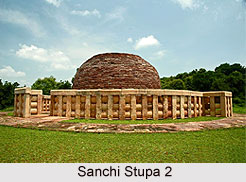 Sanchi Stupa 2 rests on an artificial terrace built against a rock shelf which is about 320 metres down the slope of the hill. Although it is similar to Sanchi Stupa 3 in terms of size and contour but it does not have any gateway. Shorn of its crowning members, berm and stairway banisters, this stupa appears somewhat bare. But it is compensated to a certain extent by the well-preserved and decorated ground balustrade with four L-shaped entrances. Its double stairway faces east. The palaeography of the inscribed records on the pradakshina-balustrade and the style of the bas-reliefs suggest that it was built around the last quarter of the second century BC, though a few reliefs were probably added later.
Sanchi Stupa 2 rests on an artificial terrace built against a rock shelf which is about 320 metres down the slope of the hill. Although it is similar to Sanchi Stupa 3 in terms of size and contour but it does not have any gateway. Shorn of its crowning members, berm and stairway banisters, this stupa appears somewhat bare. But it is compensated to a certain extent by the well-preserved and decorated ground balustrade with four L-shaped entrances. Its double stairway faces east. The palaeography of the inscribed records on the pradakshina-balustrade and the style of the bas-reliefs suggest that it was built around the last quarter of the second century BC, though a few reliefs were probably added later.
The posts of the balustrade are ornamented with one complete and two half medallions, with the exception of a few at the entrance which are carved from top to bottom. The theme of the reliefs consists mostly of decorative motifs, Buddhist subjects being a rarity. The decorative motifs include floral and plant designs, animals - real, mythological and fanciful like stag with elephant`s head or fish-tail, makaras, griffin, lion with human face, centaur with rider, woman with a horse-head, birds, fish, nagas, human figures and Jain demigods like yakshas, yakshis, kinnaras, etc. Among the floral motifs lotus is a recurring image.
Of the animals, elephants and lions are most favoured. Some of the horsemen are shown using stirrups, the earliest known representation of stirrups in India.
Incidents of the Gautama Buddha`s life are also depicted, including His Departure, Enlightenment, First Sermon and Decease which are represented symbolically by the riderless harnessed horse attended by a groom holding a parasol, the Bodhi tree within a railing having a throne in some cases, the Wheel of Dharma on a throne and the stupa.
The workmanship of the designs is primitive and contrasts sharply with the more developed art of the bas-reliefs on the gateways of Sanchi Stupa 1. The carvings illustrate the folk-art in its true indigenous character, unaffected by any sophistication.
The stupa itself is no less important on account of the body-relics of a few Buddhist teachers found within its precincts. The saints were Kasapa-gota, the teacher of all the Hemavatas, Majhima, Haritiputa, Vachhiya-Suvijayata, pupil of Gota, Mahavanaya, Apagira, Kodiniputa, Kosikiputa, Gotiputa and Mogaliputa. Kasapa-gota and Majhima, along with Dudubhisara, Sahadeva and Mulakadeva, are said in the Dipavamsa to have been commissioned by Moggaliputta Tissa, after the close of the Third Buddhist Council during the reign of Ashoka, to preach the Law in the Himavat (Himalayan) region.
A little to the north-west of Sanchi Stupa 2 and contemporary with it was a pillar with a bell-shaped lotus-capital and a crowning lion. A few fragments of the shaft are now lying on the ground, and the crowning lion is in the Sanchi Archaeological Museum.




